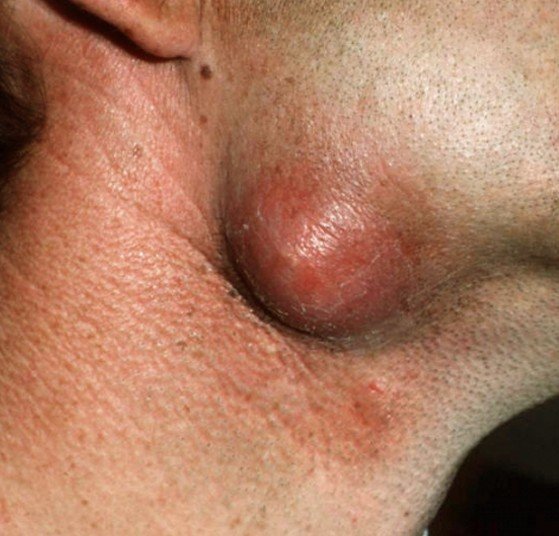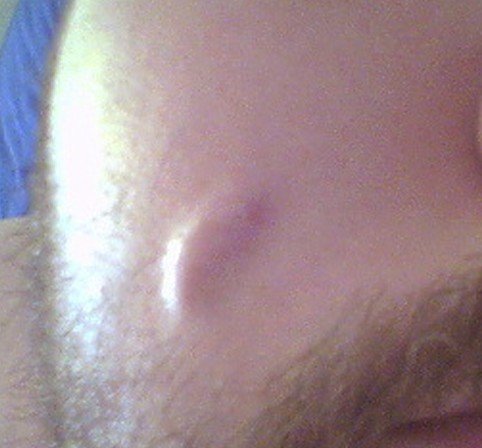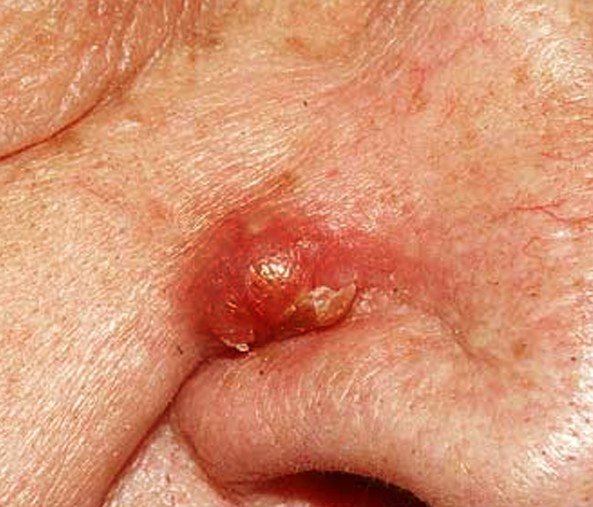Epidermoid Cyst
Last reviewed by Dr. Raj MD on January 12th, 2022.
What is Epidermoid Cyst?
This medical condition is a closed sac that develops under your skin that starts out small and grows slowly. An epidermoid cyst is normally benign, which means it is non-cancerous, but they can sometimes cause an abscess or rupture. There are rare cases in which this type of cyst has been linked with other cancers of the skin. This type of cyst is also known as infundibular cyst, keratin cyst, epithelia cyst, or sebaceous cyst. You will find epidermoid cyst normally on your face, neck, scrotum, and back but they can appear on any part of the skin and even the fingernails. The epidermoid cyst is filled with a soft material called keratin, which is a protein component of your nails, skin, and hair. Although this type of cyst can affect anyone of any age, gender, or race it is rare to see them in children and is more prominent in males, especially past puberty.
Epidermoid Cyst Symptoms
This type of cyst will usually not have any symptoms but there are characteristics of an epidermoid cyst which are:
- They are moveable and will normally move when pressed or touched.
- Can have a dome shape or be small round bumps.
- The surface of the mass is smooth.
- It can vary in size from a fourth of an inch to more than two inches.
- It is normally white or yellow but if they appear on a person with dark skin the epidermoid cyst can be pigmented.
- It could have a small opening in the center that is clogged by a blackhead.
- It can be irregular in shape or have a well-defined shape because of it re-growing, rupturing before, and scarring.
- Can become tender and red if it is infected or manipulated.
Epidermoid Cyst Causes
On the outer layer of your skin there is a very thin protective cell layer which is shed by the body on a continual basis. When these cells do not exfoliate correctly an epidermoid cyst forms when the epidermis, which is the top layer of your skin, grows into the dermis, which is the middle layer of your skin. This can happen because of having a blocked hair follicle or some type of injury. Many times an epidermoid cyst will occur in areas where there are very tiny hair follicles and much larger oil glands.
Other possible causes of developing an epidermoid cyst may include:
- Damage to your hair follicle due to being clogged by cells, damage from abrasions or surgical wounds.
- Having a ruptured sebaceous gland – these are just over the hair follicle and are the glands that produce the lubricating and coating sebum, also known as oil, of the hair shafts. They can rupture from skin conditions that are inflammatory, like from acne.
- Hereditary – these cysts are sometimes seen in the genetic disease called basal cell nevus syndrome.
Treatment
As this type of cyst does not have any symptoms it usually does not need to be treated unless it ruptures or becomes inflamed and infected. Some opt to have the removed for cosmetic reasons. If the cyst becomes inflamed, tender, and red, you should see your physician or dermatologist. They will treat the epidermoid cyst by draining the fluid out along with removing the cyst wall, or the shell that makes up the wall.
The physician or dermatologist may also prescribe antibiotics to help get rid of the infection. You can have it surgically removed for cosmetic reasons or if it is causing irritation. When you have an epidermoid cyst and do not treat it will remain there or disappear on its own. Even if they do disappear on their own they can return in the same or different places.
If the epidermoid cyst ruptures it can lead to an abscess that looks like a boil. If this happens you need to have it treated immediately. In addition, if the cyst is inflamed your physician or dermatologist can inject it with a corticosteroid to help reduce the inflammation. If you opt to have it drained they will make a small incision in the epidermoid cyst and drain out the material. This procedure is quick and easy but they can re-grow and refill with excessive keratin again.
If you want to have the epidermoid cyst removed, this can be done in three different ways:
Total excision
This is when the physician or dermatologist gets rid of the entire cyst to prevent it from ever returning. This procedure is even more effective if there is no inflammation. If there is inflammation it will first be treated with antibiotics before the total excision procedure is done which will be done approximately four to six weeks after the inflammation is gone. When you have total excision procedure done there will be sutures. If they are on the face they will be removed in a week and on other parts of the body it can be from one to two weeks.
Minimal excision
This is the option that most physicians and dermatologists prefer because it causes very little scarring and removes the entire cyst wall. There will be a small incision made in the epidermoid cyst, drains out any substances, and then gets rid of the cyst wall thru the small incision. Because it is a minor wound it is allowed to heal naturally with no sutures.
Laser removal
This is the procedure that you want to chose to minimize any scarring. The physician or dermatologist will normally use a carbon dioxide laser to evaporate the cyst.
One thing that you need to make sure that you do not do is squeeze or pop the epidermoid cyst as this can cause an infection.
Epidermoid Cyst Pictures
Collection of pictures, photos and images of Epidermoid Cyst…



